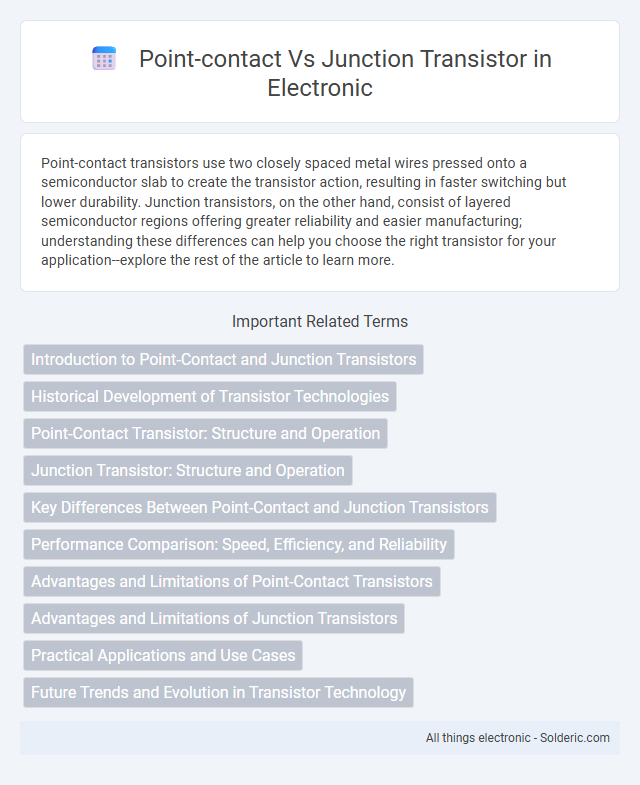Point-contact transistors use two closely spaced metal wires pressed onto a semiconductor slab to create the transistor action, resulting in faster switching but lower durability. Junction transistors, on the other hand, consist of layered semiconductor regions offering greater reliability and easier manufacturing; understanding these differences can help you choose the right transistor for your application--explore the rest of the article to learn more.
Comparison Table
| Feature | Point-Contact Transistor | Junction Transistor |
|---|---|---|
| Structure | Two closely spaced metal point contacts on a semiconductor | Three semiconductor regions forming PN junctions (Emitter, Base, Collector) |
| Development Era | First transistor type developed in 1947 | Developed in 1948, became widely used |
| Frequency Response | Lower frequency operation | Higher frequency performance |
| Current Handling | Limited current capacity | Higher current capacity |
| Reliability | Less reliable and unstable contact points | More reliable with robust semiconductor junctions |
| Manufacturing Complexity | Simple but inconsistent process | More complex fabrication with better consistency |
| Applications | Early amplification, experimental devices | Modern amplification, switching, digital circuits |
Introduction to Point-Contact and Junction Transistors
Point-contact transistors utilize two closely spaced metal contacts on a semiconductor crystal to control current flow, marking the earliest form of transistor technology. Junction transistors, including bipolar junction transistors (BJTs), feature pn-junctions formed by doping semiconductor materials, allowing for more efficient amplification and switching capabilities. Understanding the structural differences between point-contact and junction transistors helps you grasp their distinct electrical characteristics and practical applications in electronic circuits.
Historical Development of Transistor Technologies
Point-contact transistors, invented in 1947 by John Bardeen and Walter Brattain at Bell Labs, marked the first practical semiconductor amplification device, using two metal contacts pressed against a germanium crystal. Junction transistors, introduced shortly after by William Shockley, utilized a more stable and manufacturable three-layer semiconductor structure with p-n junctions, leading to widespread commercial adoption. Your understanding of transistor technology evolution reflects this transition from fragile point-contact designs to robust junction transistors, which paved the way for modern semiconductor devices.
Point-Contact Transistor: Structure and Operation
Point-contact transistors feature two closely spaced metal wires, or point contacts, placed on a thin semiconductor crystal, allowing current amplification through the flow of charge carriers at the metal-semiconductor junctions. The operation hinges on controlling electron injection and collection between the emitter and collector through a small base region formed in the semiconductor near the contacts. This structure results in fast switching speeds but generally lower durability and higher noise compared to junction transistors.
Junction Transistor: Structure and Operation
Junction transistors consist of three semiconductor regions called the emitter, base, and collector, arranged in either NPN or PNP configurations, which form two PN junctions. The operation relies on the injection and control of charge carriers through these junctions, enabling current amplification by varying the base current to modulate the larger collector-emitter current. Their layered structure allows more stable electrical characteristics and improved performance over point-contact transistors, which use point contacts instead of junctions.
Key Differences Between Point-Contact and Junction Transistors
Point-contact transistors utilize two closely spaced metallic contacts on a semiconductor crystal, creating a physical point of contact to control current flow, whereas junction transistors rely on semiconductor p-n junctions formed by doping processes. The point-contact type offers faster switching speeds due to minimal junction capacitance, but junction transistors provide superior reliability, manufacturability, and thermal stability. Junction transistors dominate modern applications because their layered structure reduces leakage currents and allows for easier integration into complex circuits compared to the delicate and less consistent point-contact design.
Performance Comparison: Speed, Efficiency, and Reliability
Point-contact transistors exhibit high switching speeds due to their simple construction but suffer from lower efficiency and less reliability compared to junction transistors, which provide superior thermal stability and longer operational lifespans. The junction transistor's layered semiconductor structure enhances charge carrier control, resulting in better amplification efficiency and consistent performance under varying electrical loads. Choosing the right transistor impacts Your device's overall speed and durability, with junction transistors favored in modern applications for their balanced efficiency and reliability.
Advantages and Limitations of Point-Contact Transistors
Point-contact transistors offer advantages such as high frequency response and simple construction, making them suitable for early amplification applications. Their limitations include fragility, inconsistent performance due to delicate contacts, and lower reliability compared to junction transistors. Understanding these factors helps you choose the right transistor type for specific electronic circuit needs.
Advantages and Limitations of Junction Transistors
Junction transistors offer higher reliability and greater gain compared to point-contact transistors, making them suitable for amplified signal applications. They possess improved durability due to their solid-state PN junctions, which reduce noise and enhance thermal stability. However, junction transistors have limitations such as slower switching speeds and greater complexity in manufacturing compared to simpler point-contact transistor structures.
Practical Applications and Use Cases
Point-contact transistors, known for their high-frequency response, are primarily used in radio receivers and early amplification circuits where low noise and sensitivity are critical. Junction transistors, with their improved durability and current gain, have become the standard in modern digital circuits, power amplification, and switching devices. Understanding your specific application's frequency, power, and reliability requirements will help determine whether a point-contact or junction transistor is the optimal choice.
Future Trends and Evolution in Transistor Technology
Point-contact transistors are largely obsolete, with junction transistors forming the foundation for modern semiconductor devices due to their enhanced reliability and manufacturing scalability. Emerging trends focus on advanced transistor architectures like FinFETs and gate-all-around FETs, which evolve from traditional junction transistor principles to optimize performance at nanoscale dimensions. Your understanding of transistor technology benefits by recognizing this shift towards more complex junction-based designs that drive future innovation in speed, power efficiency, and miniaturization.
Point-contact vs Junction transistor Infographic

 solderic.com
solderic.com